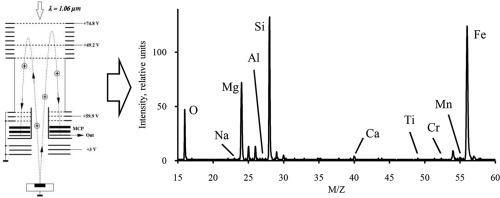International Journal of Mass Spectrometry ( IF 1.6 ) Pub Date : 2021-07-21 , DOI: 10.1016/j.ijms.2021.116676 A.E. Chumikov 1 , V.S. Cheptsov 1 , P. Wurz 2 , D. Lasi 2 , J. Jost 2 , N.G. Managadze 1

|
The laser-ionization time-of-flight mass spectrometer LASMA-LR is part of the scientific payload of the Luna-25 and Luna-27 missions. The instrument is able to perform analysis of elemental and isotopic composition of solid samples (regolith and dust) with high accuracy and high spatial resolution. The principle of the instrument operation consists in complete atomization and ionization of the substance by a laser pulse, separation of ions during their free expansion, depending on their mass and charge, and subsequent registration of the ions time of flight from the sample to the detector. The instrument has small dimensions (130 × 206 × 254 mm), low weight (2.8 kg) and low mean operating power consumption (8 W). The limits of detection for element analysis are at least 50 ppmA (ppm atomic fraction) in one mass spectrum and 5 ppmA at analysis of an accumulation of 100 mass spectra. The scientific data which will be obtained by LASMA-LR can be essential for a wide range of studies, such as the geological characteristics of spacecraft landing sites, analysis of the lunar dust composition, search for rare earth elements, native metals and alloys, determination of the content of chemically bound water in regolith, and others. Achievement of these tasks will contribute to the study of fundamental questions ranging from the formation and evolution history of the Moon to the advancement of a number of applied problems of the Moon exploration and colonization.
With the LASMA-LR instrument we have demonstrated that it is possible to provide all these analytical capabilities in a very compact, lightweight and at low power, which lends itself to operational concepts not only for robotic probes landed on the Moon, but also for proposed human spaceflight missions to the Moon and robotic missions to asteroids for the local prospection of mineral resources with a portable device, possibly as equipment carried by astronauts during their surface missions.
中文翻译:

Luna-25 和 Luna-27 太空任务中 LASMA-LR 激光电离质谱仪的设计、特性和科学任务
激光电离飞行时间质谱仪 LASMA-LR 是 Luna-25 和 Luna-27 任务科学有效载荷的一部分。该仪器能够以高精度和高空间分辨率对固体样品(风化层和灰尘)的元素和同位素组成进行分析。仪器操作的原理包括通过激光脉冲对物质进行完全雾化和电离,在离子自由膨胀期间根据其质量和电荷进行分离,以及随后记录离子从样品到检测器的飞行时间. 该仪器尺寸小(130 × 206 × 254 mm),重量轻(2.8 kg),平均工作功耗低(8 W)。元素分析的检测限在一个质谱中至少为 50 ppmA(ppm 原子分数),在 100 个质谱的累积分析中为 5 ppmA。LASMA-LR 将获得的科学数据对于广泛的研究至关重要,例如航天器着陆点的地质特征、月球尘埃成分分析、寻找稀土元素、原生金属和合金、确定风化层中化学结合水的含量等。这些任务的完成将有助于研究从月球的形成和演化历史到月球探索和殖民的一些应用问题的基本问题。LASMA-LR 将获得的科学数据对于广泛的研究至关重要,例如航天器着陆点的地质特征、月球尘埃成分分析、寻找稀土元素、原生金属和合金、确定风化层中化学结合水的含量等。这些任务的完成将有助于研究从月球的形成和演化历史到月球探索和殖民的一些应用问题的基本问题。LASMA-LR 将获得的科学数据对于广泛的研究至关重要,例如航天器着陆点的地质特征、月球尘埃成分分析、寻找稀土元素、原生金属和合金、确定风化层中化学结合水的含量等。这些任务的实现将有助于研究从月球的形成和演化历史到月球探索和殖民的一些应用问题的基本问题。
通过 LASMA-LR 仪器,我们已经证明可以以非常紧凑、轻便和低功耗的方式提供所有这些分析功能,这不仅适用于登陆月球的机器人探测器,还适用于拟议的载人登月飞行任务和小行星机器人任务,以使用便携式设备在当地勘探矿产资源,可能作为宇航员在执行地面任务时携带的设备。











































 京公网安备 11010802027423号
京公网安备 11010802027423号